Theros Beyond Death is finally fully spoiled, and you know what that means. It’s time for some scalding hot takes! It’s time for each of us to wax poetic on what cards we like and don’t like for our cubes. What harm could possibly come from throwing some fuel to this high and brilliant fire?
So here are my top picks, which i’ve separated by color and then by rarity. While these might not be The Best Cards in the Set, they’re the ones i’m most excited about and will be testing, and I think you should be too.
But first, before I get into it, a couple of words on the overall set design. As it stands, I believe the biggest boons from Theros Beyond Death to be for high synergy, low-to-middle power environments. There’s a healthy amount of support for certain fringe or underdeveloped archetypes. Enough of it that, if you’re on the fence about whether to inject, say, a draftable sacrifice deck into your cube, Theros Beyond Death’s offerings might just sway you.
White
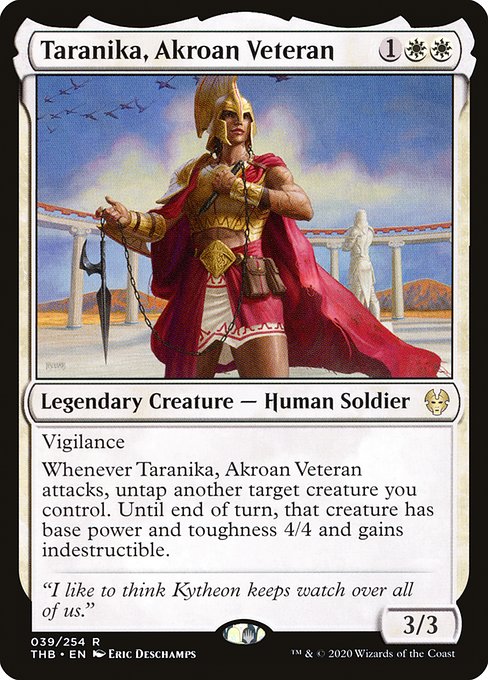
Taranika, Akroan Veteran represents a ton of potential attacking power, boosting another one of your threats into an indestructable 4/4 whenever she enters combat. Seven power crashing in as early as turn four ain’t nothing to sneeze at. While on rate a 3/3 vigilance for 1WW isn’t anything special, and there is a pervading competition at the three drop slot in White; I think Taranika has a real shot at pulling her weight for your investment.
In an aggressive White deck, combining Taranika with evasive creatures or creatures with powerful combat-related keywords—think Flying, Double Strike or Lifelink—is where Taranika really shines. She picks up a sword well, and is a human for any micro-synergies you might be looking to support. On curve she’s a house; later in the game, as with most aggressively slanted creatures, she’s less impressive, but will still apply pressure unless she’s the only creature on the board.
She probably won’t survive her first combat in an aggro mirror. Getting multiple hits in with her could be devastating for any opponent trying to race you, so expect your opponent to actively want to trade off. So look to augment her stats or expect her to die early and often. Against a more controlling deck Taranika plays right into sweepers—which makes me want to try her in a token shell, utilizing Taranika herself more as an equipment. If you can protect her in either scenario, however, she will almost certainly kill your opponent, and do so quickly.

Sagas are back! The Birth of Meletis feels tailor made for White-based control decks in Peasant cube. With a strong allusion to Wall of Omens, the amount of value you get for two mana with this card is respectible. While drawing a basic Plains and not a random card off the top of your deck is certainly less than ideal, especially as the game goes late, The Birth of Meletis still effectively replaces itself. And you know what? Value is value.
Obviously the demand for Sagas will go up the more interaction you have with enchantments, so keep this in mind when contemplating over and testing your archetypes. Enchantment recursion and blink effects are certainly possible with some of the new card interactions in Theros Beyond Death. While i’ve never seen an “enchantments matter” deck in cube, that doesn’t mean we can’t at least try it with this and some of the other new Sagas.
Blue
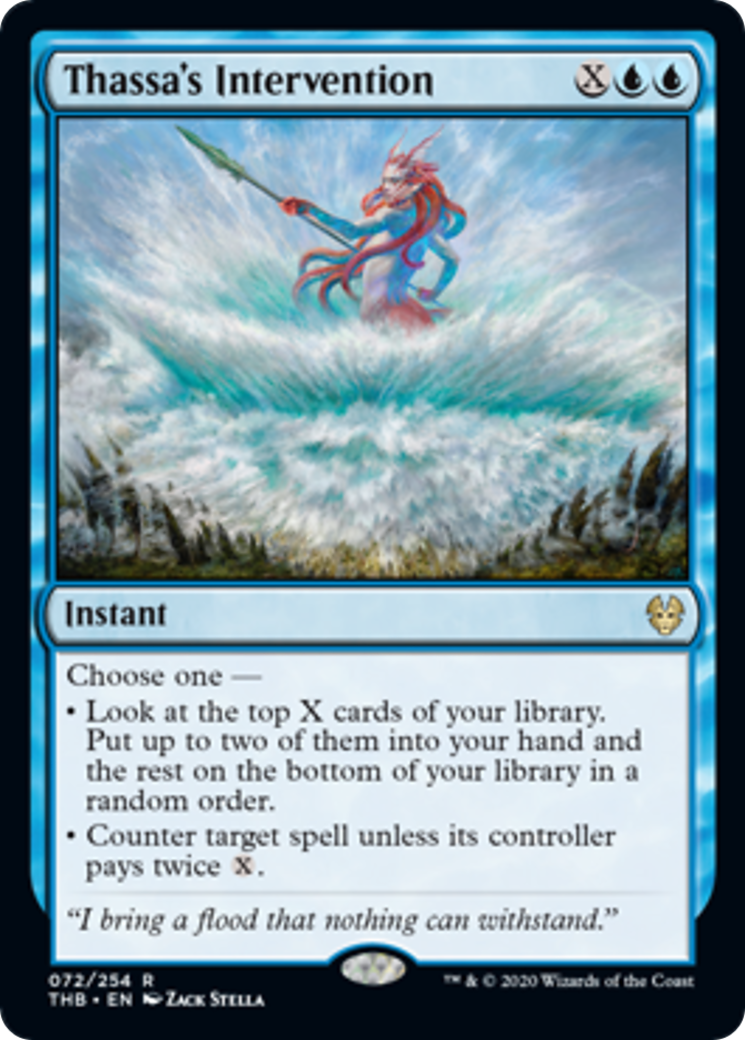
Modal spells are a fantastic design influence on modern Magic cards. Thanks largely in part to the advent of best-of-one Magic on Arena we’ve seen an influx of interesting, flexible spells like Thassa’s Intervention. Both modes are slightly overcosted for what we’d expect to pay for these effects, but we accept them when we know that the card will play differently every time we cast it. I can’t stress enough the significance of replayability with these modal spells. Having more agency is, when properly balanced, more fun for most players. It makes us feel clever, or smart, and deepens our appreciation for individual card choices during drafts and deckbuilding.
When I consider the floor to this spell—2UU to cast Inspiration, or 1UU to cast Quench—it’s hard to imagine me dismissing Thassa’s Intervention in lieu of two other, more singularly focused spells like Syncopate and Drawn From Dreams. In fact, modal card designs like Thassa’s Intervention might fundamentally call into question the function of all my counterspells and card draw spells, which feels like a wild idea. What if we are entering a world where some of the mainstays of Blue card selection and permission are replaced by these new, more flexible spells? It’s exciting to me that we can, if we choose to, more actively ride this line between optionality and efficiency in our environments.
Spells that give me agency to respond to novel situations differently each game have a lot of value. I’m looking forward to more cards like Thassa’s Intervention not just in Blue, but for all of the colors. Replayability matters.
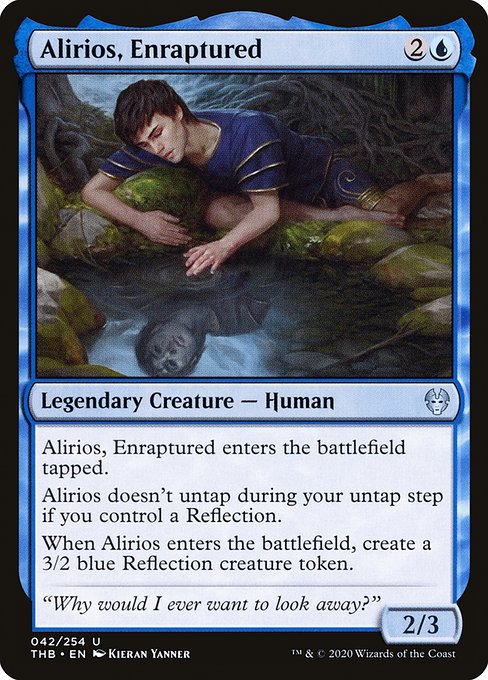
Let me first say the flavor on Alirios, Enraptured is perfect. As a top down design that tells a story, I think they’ll have a hard time besting this neat little machine in 2020. It reminds me of Blade Splicer in that you’ll want to blink him repeatedly, and will rarely if ever attack with him. Alirios is a simple, sweet addition to any Peasant cube with a blink archetype, or Blue tempo/beatdown plan.
Black
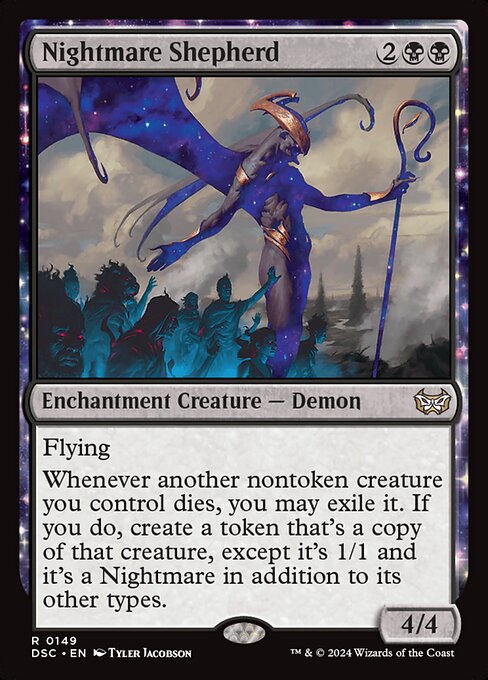
It’s weird to think that not every cube believes it wants Nightmare Shepherd. At four mana, a 4/4 flier is awesome, even a bit small compared to some of it’s spooky brethren like Desecration Demon. But it’s this static ability, which at first flew under my radar, which is a serious bit of nearly-oppressive value for aggro, midrange, or control decks.
Nightmare Shepherd has a hard target on it’s head so long as you control another meaningful creature on the battlefield, so your opponent is forced to deal with it. Otherwise they risk your other creatures coming back as 1/1’s and retriggering ETB effects. For cube this means evoke creatures will pull double duty, or Ravenous Chupacabra or Riftwing Cloudskate coming back from the dead. And, if you’re putting any relevant amount of pressure on your opponent—with a 4/4 flier this isn’t that hard to do—the time they have to do something about it can be very short.
There can be some awkward tension, too, when playing with Nightmare Shepherd. The creatures dying must be exiled in order to come back, so a deck that wants to rebuy or loop creatures from the graveyard means skipping out on some extra value. This also means death triggers can’t hit the stack either. So it’s not all free; Nightmare Shepherd does require some building around to maximize. Right now it looks to be more a value creature for decks with Birthing Pod or lots of ETB effects, and less a piece of the Recurring Nightmare/Animate Dead deck.
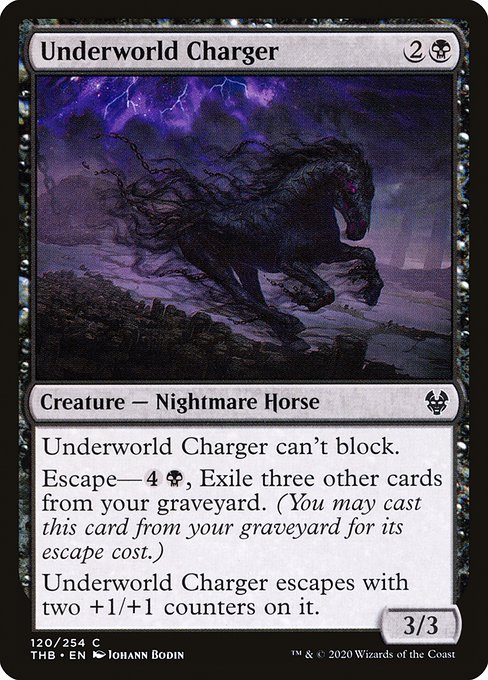
If your Pauper or Peasant cube supports an aggressive Black deck, Underworld Charger is excellent. Three mana for a 3/3 at common doesn’t come along often in Black, and for that matter neither does a five mana 5/5. We get both creatures with this one card thanks to Escape. We also get a fine payoff for graveyard based archetypes alongside cards like Tortured Existence or Grisly Salvage effects. It doesn’t block, so you’ll have to either sacrifice it or have it trade off in combat if you can’t otherwise get it into the graveyard. Which is a fine place to be with stats like this.
Red

Speaking of the Escape mechanic, say hello to Phoenix of Ash! This might be my early frontrunner for most impactful Cube card out of the entire set. Similar to Chandra’s Phoenix or Flamewake Phoenix we get a hasty, recursive flier for three mana. This phoenix, however, has the easiest recursion clause to meet. Between cheap creatures and burn spells your cards are very likely to end up in the graveyard, so expect this bird to be able to come back multiple times per game, on average.
The super firebreathing clause is pure gravy, as I don’t see it being relevant all that often, but it is a mana sink when you need one. That being said: as it seems with some of these Escape cards, your opponent is not incentivized to remove them as the escaped version of the card is often more powerful. The firebreathing ability on Phoenix of Ash could put enough pressure on the opponent that they are priced into dealing with it—which simply makes it come back even stronger.
Phoenix of Ash also plays well with spells like Faithless Looting and sacrifice outlets, as getting it into the graveyard jump-starts the better half of the card. I don’t know if anyone is still sleeping on this card at this point, but just in case you care, definitely consider adding Phoenix of Ash to your list.
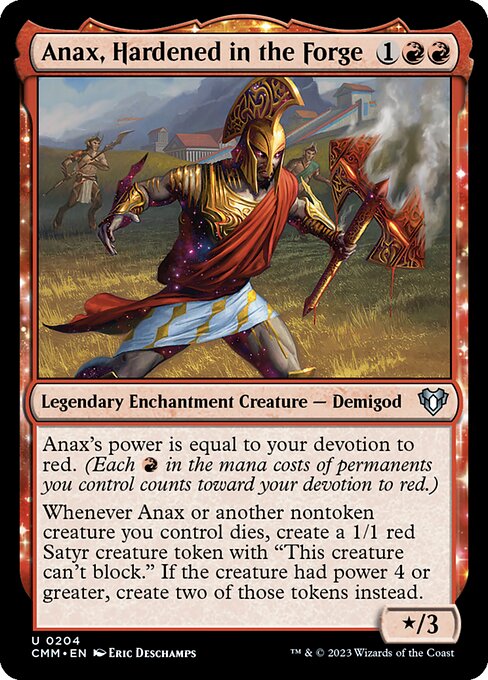
Anax, Hardened in the Forge is an excellent addition to Peasant cubes. At it’s floor he’s a three mana 2/3 that dies and makes a 1/1. If he lives, he’s an absolute powerhouse for sacrifice strategies. Every creature you control dies into a 1/1, and sometimes two 1/1’s so long as you continue to control Anax. This is exacltly the kind of static effect you want in sacrifice decks to keep your fodder count high.
Anax is also a Red-heavy beatdown card. His power grows fast as you play to the board, so clearing a path for him once or twice and Anax is capable of dealing huge amounts of damage. I’m really impressed by how much power is packed into this little uncommon. Just remember: those tokens cannot block!
Green
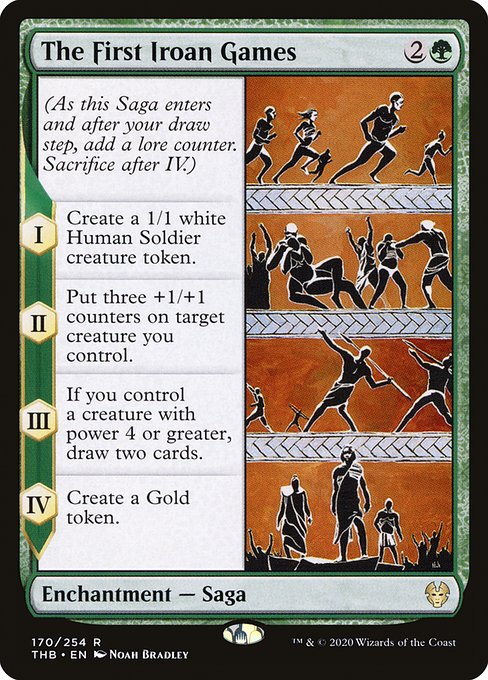
Let me get this straight. I get a 4/4 creature, draw two cards, and a Lotus Petal all for three mana? This card is unbelievably good. Yes, all these effects are on somewhat of a time delay, but consider how this might play out. You cast this on turn 2 thanks to Llanowar Elves and make a 1/1 token. Now your opponent has to hold up a removal spell in order to negate having a 4/4 attacker on turn 3. If they don’t kill your 4/4, now they have one turn to interact before you get to draw two cards. This, of course, says nothing of you simply continuing to curve out and play more creatures while this is happening.
In the worst case scenario, they kill your 1/1 before Chapter II and you can’t play another creature, which seems highly unlikely for most heavy Green cube decks. In any environment where Green decks want to beat down, this looks like a slam dunk. The Frist Iroan Games also interacts with human synergies and +1/+1 counter synergies, making me even more excited to try it in a low-to-mid tier power level.

I’m a fan of reach creatures in Green and loved the printing of Kraul Harpooner last year, so Chainweb Aracnir certainly has my attention. This has perfect synergy with defensive, graveyard-centric archetypes that revolve around win conditions like Spider Spawning. As I’ve alluded to before, the Escape mechanic is a really exciting way to interact with the graveyard and I’m looking forward to exploring its exploits in cube. Chainweb Aracnir won’t always be a 2-for-1, but it’s a good piece of value that can help prolong the game a bit, if nothing else. When the spider is good, however, it’s ETB can be backbreaking.
Multicolor
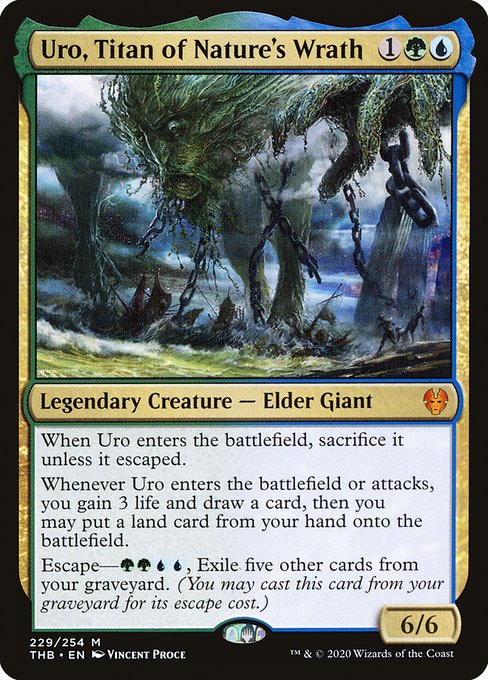
Titan’s are back! Well, sort of. Anytime I see creatures that have the “When [this] enters the battlefield or attacks,” I’m immediately reminded of the original titans. Uro, Titan of Nature’s Wrath will be an interesting stress test for the expectations of the Escape mechanic. But before I get into that, how good is this up front?
If you can cast Uro on curve, you’re ramping, but at the cost of a land from your hand. This has a reasonable fail rate in a deck with lots of mana dorks and a slightly lower land count. It’s an expensive Explore at worst, and we get a small life cushion to not feel too punished for using a turn on this effect. As for the Escape, if you can get there, you’ve got a massive beater that will certainly get you ahead if you can keep untapping with it.
But how difficult is it to get those five extra cards into your graveyard? There’s no reasonable way to say at this point, but cube decks in Simic don’t have the easiest of times filling their graveyards quickly. They mostly pay to the board. And my final question I want answered: Are we trying to get Uro, Titan of Nature’s Wrath out quickly? Or do we just let the game continue to play out naturally and get our value later?
I have no idea, but i’m excited to find out.
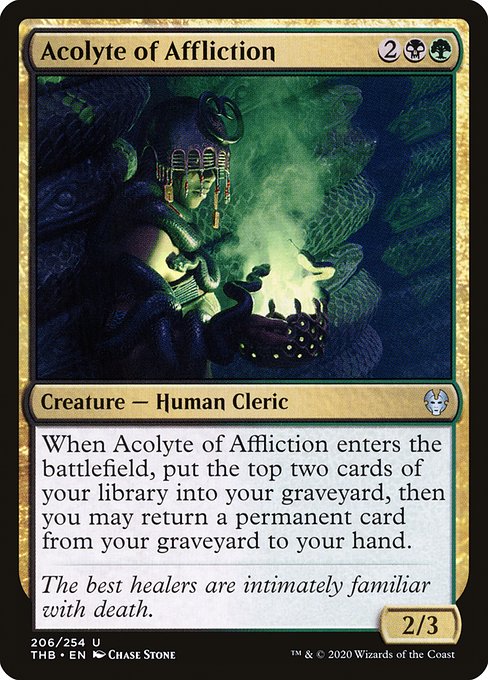
I really wanted Goglari Findbroker to work, but the casting cost was often a little too cumbersome for the average cube deck that wanted it. Acolyte of Affliction is similar, and better in a few small but meaningful ways. We’re trading some power and toughness for a much easier casting cost, and the ability to self-mill. This card should bolster any Peasant cube with a grindy graveyards theme, providing both a set-up and a payoff for high synergy deckbuilding.
That’s it for now! As I said at the top, we’ve got a lot of synergy tools on our hands, which should hopefully bring about better supported or even new archetypes for our cubes. What did you think of my list? Anything you’re excited about testing from Theros Beyond Death?
Thanks for reading.

